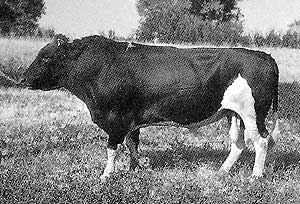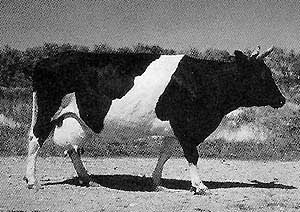Aulie-Ata Cattle
 The creation of this breed started in 1885 in the Aulie-Ata district of Kirgizia.
The local Kazakh cattle were crossed with the Dutch Black Pied breed and the crosses
were bred inter se. The crossbreds gradually spread to other regions of Kirgizia and
Kazakhstan and to some areas of Uzbekistan. They were recognized as an official breed
in 1950. Planned breeding of Aulie-Ata cattle began in 1935 when collective breeding
farms and state breeding stations were set up; local cows were initially crossed with
East Friesian bulls and the crosses were raised under improved conditions of feeding
and management.
The creation of this breed started in 1885 in the Aulie-Ata district of Kirgizia.
The local Kazakh cattle were crossed with the Dutch Black Pied breed and the crosses
were bred inter se. The crossbreds gradually spread to other regions of Kirgizia and
Kazakhstan and to some areas of Uzbekistan. They were recognized as an official breed
in 1950. Planned breeding of Aulie-Ata cattle began in 1935 when collective breeding
farms and state breeding stations were set up; local cows were initially crossed with
East Friesian bulls and the crosses were raised under improved conditions of feeding
and management.
Modern Aulie-Ata cattle are well adapted to the local natural and climatic conditions; they can easily withstand hot weather, can be kept on mountain pastures, and they are more resistant than imported breeds to theileriosis and piroplasmosis.
 In conformation the Aulie-Ata resembles Dutch cattle: the body is long, with a light
head, small horns, and thin neck with few wrinkles. The top line (withers, back and
loin) is level with slightly raised rump. The udder is medium in size and cupshaped.
Coat color is mainly black, frequently with white spots on the abdomen, udder, lower
chest and legs; light grey animals are also observed. The average measurements of
mature cows are as follows (in cm): withers height 128.8, chest depth 69.2, oblique
body length 153.0, heart girth 186.2, cannon bone girth 18.7 (National Herdbook, vol.
4). The average live weight of mature cows at breeding farms is 480-510 kg; the heaviest
cows weigh 575 kg. The live weight of mature bulls is 810-960 kg; the maximum weight
is 1160 kg.
In conformation the Aulie-Ata resembles Dutch cattle: the body is long, with a light
head, small horns, and thin neck with few wrinkles. The top line (withers, back and
loin) is level with slightly raised rump. The udder is medium in size and cupshaped.
Coat color is mainly black, frequently with white spots on the abdomen, udder, lower
chest and legs; light grey animals are also observed. The average measurements of
mature cows are as follows (in cm): withers height 128.8, chest depth 69.2, oblique
body length 153.0, heart girth 186.2, cannon bone girth 18.7 (National Herdbook, vol.
4). The average live weight of mature cows at breeding farms is 480-510 kg; the heaviest
cows weigh 575 kg. The live weight of mature bulls is 810-960 kg; the maximum weight
is 1160 kg.
In one of the best herds, that belonging to the breeding center at Pobeda collective farm in Chimkent region of the Kazakh Republic, there are three conformational and performance types: narrow-bodied dairy (31.4%), wide-bodied dairy (38%), and dairy-beef (30.6%). The types differ in both external and internal characteristics - in both live weight and milk and beef productivity. Under the same conditions of feeding and management the most productive mature cows are those of the wide-bodied dairy type; their milk yield is 20.5% higher than that of the narrow bodied dairy cows. They also have more regular lactations. The wide-bodied dairy cows weigh 33 kg more than the narrow-bodied type. The reproductive ability of the wide bodied cows, measured by the average calving interval and service period, is also higher. For farms of the "whole milk zone" in the south of the Kazakh Republic preference should be given to wide-barreled dairy animals as the most productive, the largest and having the best food conversion.
The average milk production of mature cows, as recorded in the National Herdbook (vol. 4), is 3735 kg, with fat content of 4.01%.
The most productive herds of Aulie-Ata cattle in recent years are as follows: The herd of Jambul sugarbeet state farm of the Kazakh Republic: the milk yield of mature cows there reached 4971 kg, with fat content of 3.82%. The herd at the 22 Partsyezd collective farm of Jambul region which averaged 4157 kg of milk and 158 kg of milk fat in 1979. In 1982 in the herd of V.I. Lenin collective farm of Jambul region the average was 3806 kg of milk and 146 kg of milk fat. In 1983 the breeding farm of Pobeda collective farm of Talass region of the Kirgiz SSR with 705 head of cows had an average yield of 3636 kg of milk and 136 kg of fat.
Aulie-Ata cattle fatten well. When fattening on pasture without additional feeding the daily gain of steers is up to 1 kg. The dressing percentage is 52-56; for some animals it is up to 60. The beef is tender, very tasty, highly nutritious.
The breed includes 6 blood lines and 2 related groups. Its numbers at the beginning of 1980 were 265,000 head.
The most valuable features of this breed are as follows: adaptation to the ecological conditions of the breeding zone, high vitality and strong constitution. To preserve and better use this genetic resource it is necessary to improve the economic basis of the breeding farms, to intensify the techniques of selection, to set up an adequate bank of frozen semen of the best sires of the breed. The major breeding aim is to increase milk yield and fat content and to improve the conformation and beef qualities. To help with this program it will be expedient to use the blood of related breeds - the Dutch Black Pied and the Holstein.
References
Dmitriez, N.G. and Ernst, L.K. (1989) Animal Genetic Resources of the USSR. Animal Production and Health Paper Publ. by FAO, Rome, 517 pp.
